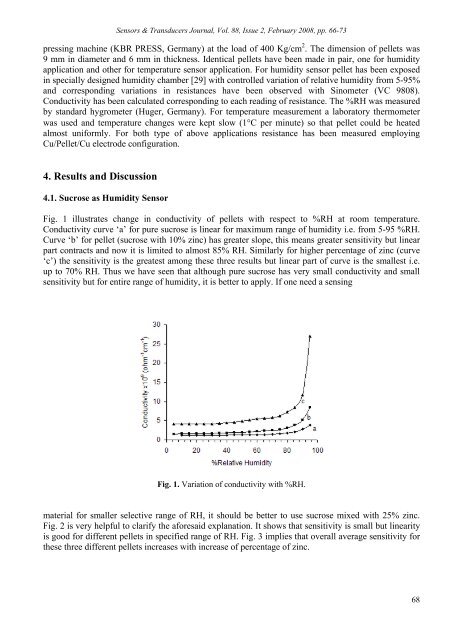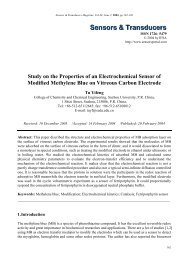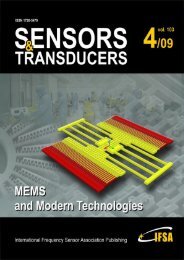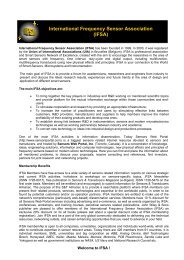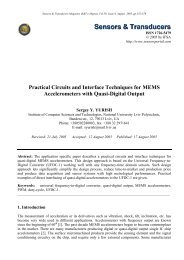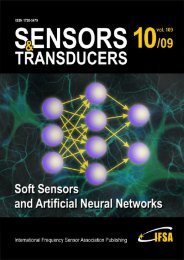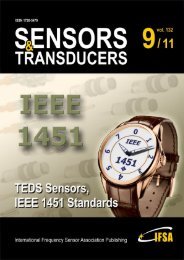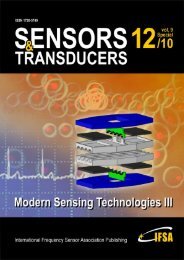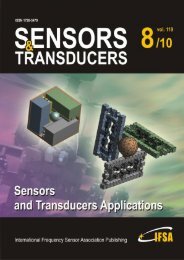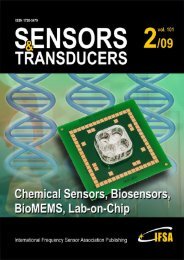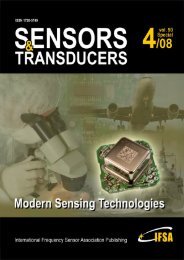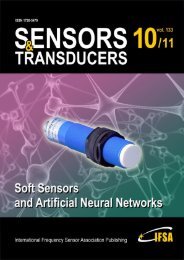Solid-State Conductivity of Sucrose and its Applications as Humidity ...
Solid-State Conductivity of Sucrose and its Applications as Humidity ...
Solid-State Conductivity of Sucrose and its Applications as Humidity ...
You also want an ePaper? Increase the reach of your titles
YUMPU automatically turns print PDFs into web optimized ePapers that Google loves.
Sensors & Transducers Journal, Vol. 88, Issue 2, February 2008, pp. 66-73<br />
pressing machine (KBR PRESS, Germany) at the load <strong>of</strong> 400 Kg/cm 2 . The dimension <strong>of</strong> pellets w<strong>as</strong><br />
9 mm in diameter <strong>and</strong> 6 mm in thickness. Identical pellets have been made in pair, one for humidity<br />
application <strong>and</strong> other for temperature sensor application. For humidity sensor pellet h<strong>as</strong> been exposed<br />
in specially designed humidity chamber [29] with controlled variation <strong>of</strong> relative humidity from 5-95%<br />
<strong>and</strong> corresponding variations in resistances have been observed with Sinometer (VC 9808).<br />
<strong>Conductivity</strong> h<strong>as</strong> been calculated corresponding to each reading <strong>of</strong> resistance. The %RH w<strong>as</strong> me<strong>as</strong>ured<br />
by st<strong>and</strong>ard hygrometer (Huger, Germany). For temperature me<strong>as</strong>urement a laboratory thermometer<br />
w<strong>as</strong> used <strong>and</strong> temperature changes were kept slow (1°C per minute) so that pellet could be heated<br />
almost uniformly. For both type <strong>of</strong> above applications resistance h<strong>as</strong> been me<strong>as</strong>ured employing<br />
Cu/Pellet/Cu electrode configuration.<br />
4. Results <strong>and</strong> Discussion<br />
4.1. <strong>Sucrose</strong> <strong>as</strong> <strong>Humidity</strong> Sensor<br />
Fig. 1 illustrates change in conductivity <strong>of</strong> pellets with respect to %RH at room temperature.<br />
<strong>Conductivity</strong> curve ‘a’ for pure sucrose is linear for maximum range <strong>of</strong> humidity i.e. from 5-95 %RH.<br />
Curve ‘b’ for pellet (sucrose with 10% zinc) h<strong>as</strong> greater slope, this means greater sensitivity but linear<br />
part contracts <strong>and</strong> now it is limited to almost 85% RH. Similarly for higher percentage <strong>of</strong> zinc (curve<br />
‘c’) the sensitivity is the greatest among these three results but linear part <strong>of</strong> curve is the smallest i.e.<br />
up to 70% RH. Thus we have seen that although pure sucrose h<strong>as</strong> very small conductivity <strong>and</strong> small<br />
sensitivity but for entire range <strong>of</strong> humidity, it is better to apply. If one need a sensing<br />
Fig. 1. Variation <strong>of</strong> conductivity with %RH.<br />
material for smaller selective range <strong>of</strong> RH, it should be better to use sucrose mixed with 25% zinc.<br />
Fig. 2 is very helpful to clarify the aforesaid explanation. It shows that sensitivity is small but linearity<br />
is good for different pellets in specified range <strong>of</strong> RH. Fig. 3 implies that overall average sensitivity for<br />
these three different pellets incre<strong>as</strong>es with incre<strong>as</strong>e <strong>of</strong> percentage <strong>of</strong> zinc.<br />
68


